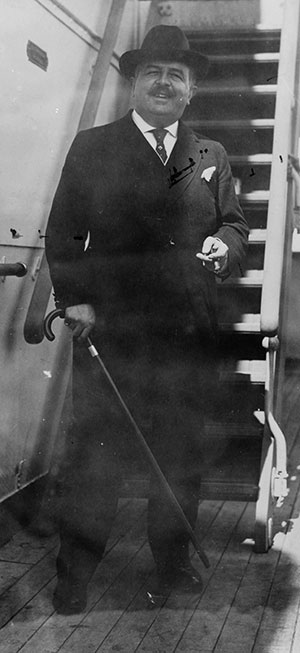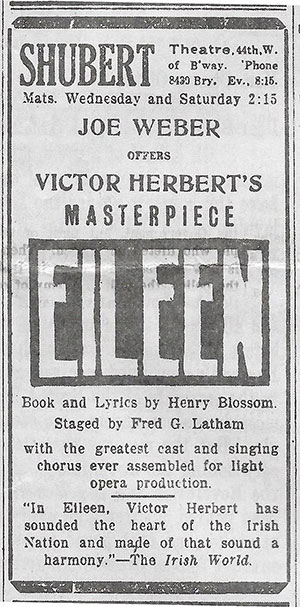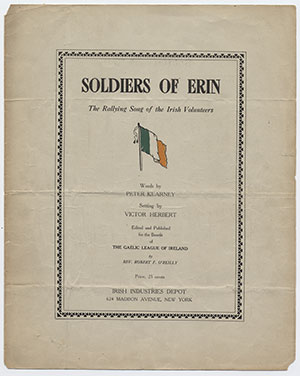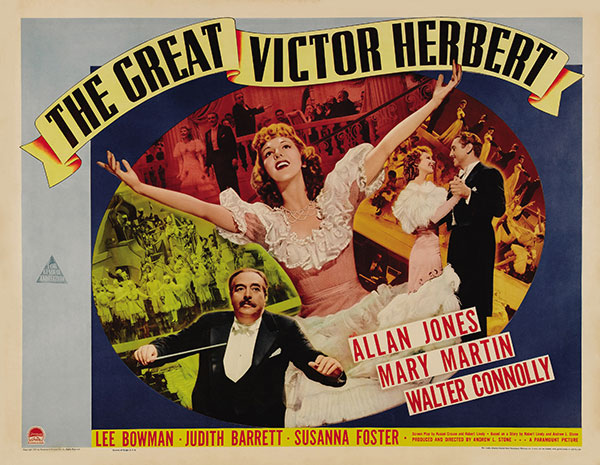Was Victor Herbert Irish?
Published in 18th–19th - Century History, Features, Issue 1 (January/February 2017), Volume 25ALTHOUGH HE NEVER SET FOOT IN IRELAND, HE CONFIDENTLY PROCLAIMED HIS ETHNICITY
By Marion R. Casey
‘No, he is not an Irishman. He was born in Ireland; but being born in a stable does not make a man a horse’
—Daniel O’Connell (referring to the duke of Wellington), Mullaghmast, 1843.

Above: Victor Herbert in June 1914. (Library of Congress)
All accounts of the composer and conductor Victor Herbert (1859–1924) name Dublin as his birthplace, credit Germany for his musical training and acknowledge America as his adopted country. Six weeks before the Easter Rising, Herbert—who was not usually active in politics—became president of the Friends of Irish Freedom, a new American advocacy group established by the March 1916 Irish Race Convention in New York City.
With a sense of identity that was more complex than most, Victor Herbert’s involvement in Irish nationalism has perplexed all his biographers. They conclude that his ties with Ireland were simply an emotional indulgence and instead focus on the astonishing versatility that produced a body of work for cello, violin, piano, band and orchestra, in addition to operas, operettas and recordings, which made Herbert a musical celebrity in the United States in the first decades of the twentieth century. But from 1886 Herbert was exploring his ethnicity through musical expression. Why? Because his mother Frances, daughter of the famous Irish artist and author Samuel Lover, told him that he was Irish and he never had cause to believe otherwise.
His mother, Fanny Lover
In 1850, when she was just sixteen, Frances (Fanny) Lover married Frederic Muspratt on 3 July at St Marylebone Church in London. He was the son of her father’s long-time friend James Muspratt, the Dublin-born chemical industrialist. Frederic was one of four sons in the family business, so the young couple settled in Greenfield Hall, Holywell, near the Welsh alkali plant in Flint that Frederic and his brother Richard took over in advance of James’s retirement. Samuel Lover visited Fanny there, and his first grandchild, Angela Lucy Winifred Muspratt, was born at Holywell in November 1851.
Shortly thereafter Frederic and Fanny moved to the Continent, spending most of their time in Germany, where Justus von Liebeg, another old friend of James Muspratt’s, was the centre of chemical innovation at the time. But Frederic had wanderlust and in 1853 went to Morocco, then early the following year to Australia, leaving twenty-year-old Fanny with a toddler and an infant son. When Frederic returned in early 1857 his wife was nowhere to be found. Their long separation had been compounded in August 1856 by the death of their young son, ultimately propelling Fanny into the arms of August Herbert, about whom nothing is known. Victor August Herbert, the child of this affair, was born on 1 February 1859 (probably on the island of Guernsey) and was baptised that summer in the Lutheran church in Freiburg, Germany.
A detective tracked Fanny from Freiburg to Paris and Le Havre, where he found her living with Angela and baby Victor in early 1860. When confronted, she refused to name Victor’s father, and on that basis Frederic took Angela and sued for divorce in March 1861. The English census, taken the following month, finds ‘Fanny Muspratt’ and her son ‘Victor Augustus Muspratt’ in a Southampton boarding-house, but in the end she did not appear in court to defend herself. The marriage was officially dissolved in March 1862 on the grounds of adultery.
This was a watershed moment for the children. Muspratt family historians believe that Fanny died before 1861. (In fact, she lived until at least 1915.) Victor grew up thinking that his father died that same year and apparently never knew that he had a half-sister. There is also no evidence that Samuel Lover ever saw Angela, described as an ‘artist’ in the 1871 English census, again before his death in 1868. Fanny and Frederic successfully erased their time together and moved on.
Fanny’s first recourse was her father’s home in Sevenoaks, Kent, and this is where Victor’s strong sense of Irishness was incubated between 1862 and 1866. As an adult the memories of those years remained fresh, and he often spoke of his grandfather’s lively companionship.
Proclaimed his Irishness
Victor Herbert’s papers, donated to the Library of Congress by his daughter, shed no light on the circumstances surrounding his paternity. As late as 1914, Fanny perpetuated the fiction that Herbert had been born in Ireland of a long paternal line of distinguished Irishmen. This has led to speculation, most recently by the biographer Neil Gould, who published a family tree that incorrectly places the composer as one of the Herberts of Currans and Cahernane in Killarney, cousins of the Herberts of Muckross House. Would his ethnic identification have been any different if August Herbert had married Fanny and raised his son as a German? In fact, his mother married another German, Carl Theodor Schmid, in Wimbledon in September 1864 and three years later settled the family in Germany, where Victor was enrolled at the School Illustre, Stuttgart. Since his entire education as man and musician was there, Germany might have had an equal claim to his sense of identity. Nevertheless, although he never set foot in Ireland, he confidently proclaimed being Irish all his life:
‘Blood will tell, especially Irish blood … I’m a grandson of Samuel Lover and was born in Dublin myself, and it should not seem strange that an Irishman could and should write Irish song, or an Irish rhapsody. A real Irish song has to come from the soul … and an Irish soul by preference.’
He rejoiced ‘that the memories of my earliest childhood are inseparable from the Irish melodies sung over my cradle by my mother’. Herbert’s time in Sevenoaks certainly speaks volumes about the durability of Lover’s affinity for Ireland, even after decades living in England, and of the undiluted way in which a sense of Irishness was transmitted to a third generation in the diaspora through music.

Above: An advertisement for Herbert’s operetta Eileen, a tribute to his grandfather Samuel Lover’s popular novel and play Rory O’More, which, like Eileen, was set in 1798. (Gaelic American, 14 April 1917)
The Easter Rising crystallised this for Herbert. In its wake, his decision to write an operetta, Eileen, on an Irish nationalist theme was a long-overdue tribute to his grandfather, especially a nod to Lover’s popular novel and play Rory O’More, which, like Eileen, was set in 1798.
The composer also had a long relationship with the Gaelic Society of New York, for whom he wrote the Irish Rhapsody in 1892. In 1908 he joined the Friendly Sons of St Patrick, the oldest Irish association in New York, and in 1911 he became a member of the American Irish Historical Society. All had overlapping networks of cosmopolitan men and women whose names and patronage carried weight in politics, society and the arts. In this way the composer was casually exposed to constitutional and republican opinions on nationalism then current among educated Irish-American professionals. The results include Herbert compositions, orchestrations and concerts through which he explored Ireland’s music as cultural nationalism, not only for himself but also for the American public. They also propelled him to the presidency of both the Friendly Sons and the Friends of Irish Freedom in the spring of 1916. Herbert’s celebrity thus helped to escalate the call for Irish independence to a national level in the United States.
In this context critics either received Eileen as propaganda (Herbert conducted the première ‘with all the ardor of a rebel’) or as old-fashioned. The Boston Daily Globe called it ‘rather conventional in its fidelity to the stage tales of Irish patriotism that have been standard since the days of Boucicault’. The powerful Clan na Gael leader John Devoy, on the other hand, whatever he actually thought of its artistic merit, understood its value for the cause and declared that Eileen ‘pulsates with a passionate devotion to Ireland and breathes the deathless spirit of Irish nationhood’.

Above: In late 1916, Herbert orchestrated ‘Soldiers of Erin, the Rallying Song of the Irish Volunteers’, which appeared simultaneously with Cathal MacDubhghaill’s arrangement of ‘A Soldier’s Song’, published in Dublin. Both use the same melody and English words (with slight variation). (Ward Irish Music Archives, Milwaukee)
In late 1916, as he was finishing his Irish operetta, Herbert also orchestrated ‘Soldiers of Erin, the Rallying Song of the Irish Volunteers’. For all practical purposes, it appeared simultaneously with Cathal MacDubhghaill’s arrangement of ‘A Soldier’s Song’, published in Dublin in December 1916. Both use the same melody and English words (with slight variation) of the Peadar Kearney/Patrick Heaney composition that was sung in the GPO during the Easter Rising and in the internment camps afterwards. Fr Robert O’Reilly got the tune from Robert Monteith’s son and they somehow connected with Victor Herbert. The result was a score for orchestra, as well as a piano version, published for the benefit of the Gaelic League. The priest claimed copyright for editing the latter and it was duly filed in the United States on 14 January 1917. As early as 2 March it was on the West Coast, as part of the Emmet programme of the Knights of the Red Branch in San Francisco. By May it was being sung at a rally in Hibernian Hall, Seattle. A 50-piece orchestra under Herbert’s baton played ‘Soldiers of Erin’ at a special Carnegie Hall programme to mark the first anniversary of the Rising. The Gaelic American reported that Herbert ‘created an atmosphere of patriotism and a feeling of kinship and association with all those who died for Ireland that was impossible to resist. He thrilled and inspired the entire proceedings in a really magnificent way.’ By the time Éamon de Valera arrived in 1919, the song had been sung as the Irish national anthem all across America for a full two years.

Above: Poster for The Great Victor Herbert, a 1939 musical starring Walter Connolly in the lead role.
So was Victor Herbert Irish?
While he did not live long enough to see it officially adopted by the Irish state in 1926, it was Victor Herbert’s version of the anthem as performed widely in the United States and recorded for the Emerson label in 1919 that gave it so much traction. He modestly called it his ‘small contribution to the cause of Ireland’. Herbert’s birthplace mattered little to a country like the United States, struggling for musical recognition from Europe during his lifetime. He is as often claimed as the foremost American composer of his day as he is included in the pantheon of Irish-America’s famous sons. Although he wasn’t born in Ireland, Ireland was firmly part of Victor Herbert. More than symbolic ethnicity, it was a personal choice that he cultivated for decades in ways that would not have been possible had he remained in Germany. It was also the fulfilment of choices made unbeknownst to him by young Fanny Lover.
Marion R. Casey lectures in history at New York University’s Glucksman Ireland House.
Read More:
Samuel Lover (1797–1868)
Fanny Lover (1834–c. 1915–20)
FURTHER READING
W.B. Bernard, The life of Samuel Lover (London, 1874).
M. Casey, ‘Victor Herbert, nationalism, and musical expression’, in M.N. Grey (ed.), Ireland’s allies: America and the 1916 Easter Rising (Dublin, 2016).
N. Gould, Victor Herbert: a theatrical life (New York, 2008).
P. Reed, Entrepreneurial ventures in chemistry: the Muspratts of Liverpool, 1793–1934 (Oxford, 2016).
















